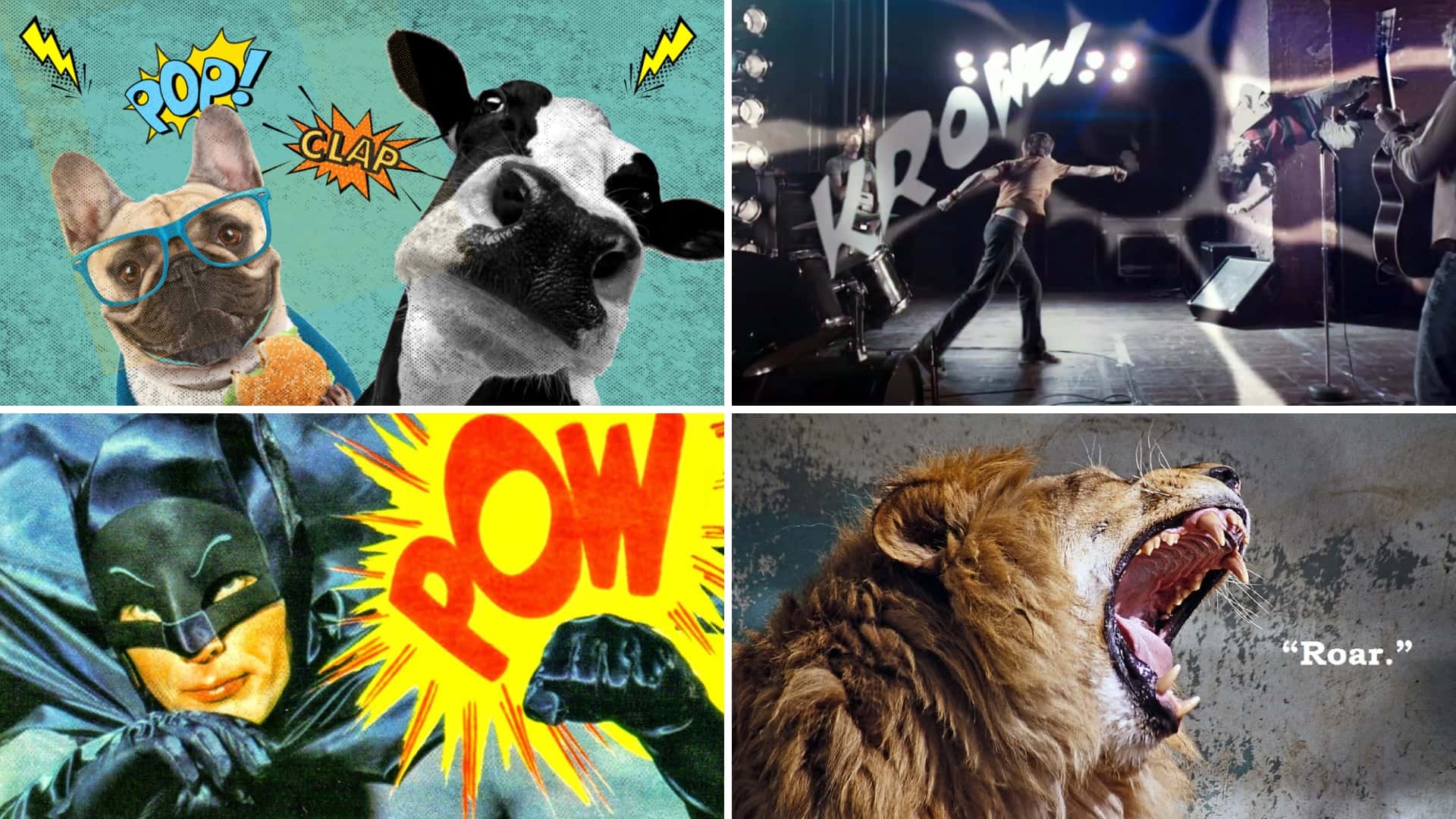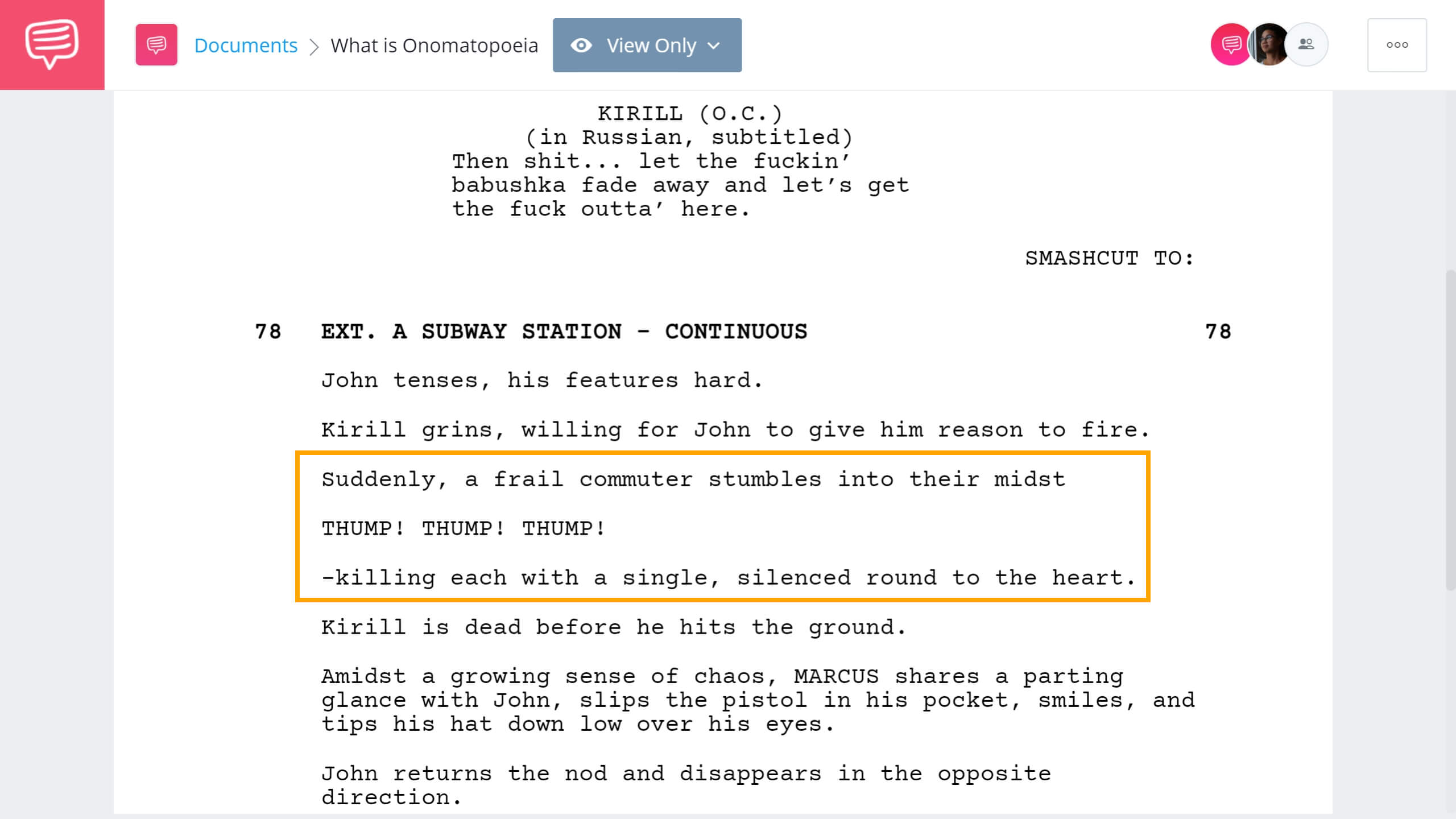What is onomatopoeia? It’s the literary device that hits with a BANG, lands with a THUD, and brings language to life in creative writing through sound. From comic books and classic literature to modern screenplays, onomatopoeia mimics the sounds of the world around us—buzzing, ticking, crashing—to create vivid, immersive storytelling. In this guide, we’ll define onomatopoeia, break down the different types, and explore onomatopoeia examples that show how writers use sound to spark emotion, action, and rhythm on the page.
What is Onomatopoeia
The definition of onomatopoeia
So, what is onomatopoeia? It’s the literary device that lets language mimic the world around us—buzzing bees, ticking clocks, crashing waves. The word onomatopoeia may be hard to say and even harder to spell, but its meaning is surprisingly uncomplicated.
Put simply, it’s a word that sounds like the thing it describes—like buzz, bang, or pop. Before we look at some vivid onomatopoeia examples, let’s start with a clear onomatopoeia definition.
ONOMATOPOEIA DEFINITION
What is onomatopoeia?
Onomatopoeia is a literary device that uses the letter sounds of a word to imitate natural sounds emitted from an object or action. The word onomatopoeia can be traced back to the Ancient Greek word “onomatopoiia” which means the making of a word or name.
It can be found throughout language to assign certain words to the sound of an object or action. For example, “buzzing” may refer to the sound of a bee or “tick-tock” to the sound of a ticking clock.
How to Pronounce Onomatopoeia: on-oh-mott-oh-PEA-uh
Benefits of using onomatopoeia
- Adds rhythm to the action
- Creates vivid, immersive imagery
- Allows reader to understand the sound being expressed
What is onomatopoeia
Examples of onomatopoeia
Even though we’ve covered the onomatopoeia definition, it may be difficult to understand without first answering the question: What is an onomatopoeia? The definition of onomatopoeia is simple: it’s a word that imitates the sound it represents. Let’s look at a few onomatopoeia examples to clarify.
The tree fell in the forest and landed with a loud thump.
He was just about in bed when he heard a ding-dong from the doorbell.
The bee buzzed right above our heads.
Knock-knock. All of their heads turned toward the front door.
He ducked, but it was too late. Whack! The branch knocked him off his bike.
We tiptoed through the living room and heard a woof from the backyard.
Onomatopoeia is a mechanism that allows the reader to understand the literal sound being communicated through the word. Now that we’ve covered a few everyday onomatopoeia examples, let’s take a look at how writers use them.
Types of Onomatopoeia with Examples
Types of onomatopoeia explained
Writers use different types of onomatopoeia to bring scenes to life. Each word imitates a sound tied to a specific source or action, helping the reader instantly hear what’s happening.
Animal sounds like meow or woof convey instincts or tension.
Weather sounds like drip or boom suggest atmosphere and tone.
Mechanical sounds such as tick tock or clang create rhythm and urgency.
Human sounds like a giggle or a gargled add intimacy or realism.
Impact sounds, such as bang or thud, bring physical moments to the page. A sharp sound like “crack” or “snap” can jolt the reader’s attention and heighten intensity.
Each of these onomatopoeic words delivers a specific onomatopoeic effect, mimicking the sound they describe. These are classic examples of sound words that immerse the audience deeper into the moment.
Related Posts
Onomatopoeia Meaning and Definition in Literature
Examples of onomatopoeia in literature
Writers often define onomatopoeia as a tool for making language more immersive. It is commonly used in literature to engage a reader and bring them into a story. Before we dive into a literary example, take a look at this video to better understand the meaning behind it.
What Is Onomatopoeia? The deeper onomatopoeia meaning
Onomatopoeia can capture a reader's attention and create depth in the world of a novel. For example, in Ernest Hemingway’s For Whom the Bell Tolls, Hemingway uses it to bring the reader into the world of the novel and experience of its characters. He writes:
“He saw nothing and heard nothing, but he could feel his heart pounding, and then he heard the clack on stone and the leaping, dropping clicks of a small rock falling.”
The “clack” of the stone and “clicks” of a small rock falling bring the story to life. Onomatopoeia doesn’t stop on the page. Screenwriters use it to drive home cinematic moments through sound cues and action beats in a screenplay.
Related Posts
Onomatopoeia in Film and Screenwriting
Onomatopoeia examples in screenplays
A common question is: What is an onomatopoeia in film writing?
It’s a tool for embedding sound cues directly into the script. This often includes finding ways to write more cinematic elements. When it comes to writing sound effects that are integral to a script’s plot, onomatopoeia is a screenwriter's best friend.
It is commonly used to portray the sound of objects and actions, which is especially important when writing an epic fight scene. Even more specifically, in this video tutorial, we break down techniques and tips for how to write a fight scene, like using onomatopoeia whenever a big moment in the fight occurs.
Using Onomatopoeia in a fight scene: John Wick • Subscribe on YouTube
Want to see onomatopoeia in action? Open the John Wick screenplay and watch how screenwriter Derek Kolstad uses a single word—“THUMP”—to land a punch that you feel as much as read. This isn’t just a definition on paper—it’s cinematic sound design on the page.
Example of Onomatopoeia in Film: John Wick • Read Full Scene
The use of “THUMP” not only tells the reader what is happening, but also makes the scene more cinematic, as it will be experienced on screen. It’s a perfect example of effective onomatopoeia sound-enhancing visual storytelling.
How to Format Sound Effects in Screenwriting
In professional screenwriting, key sound effects—especially onomatopoeia sounds—should always appear in ALL CAPS within the action lines.
John Wick script example:
John takes a hit — THUMP — and drops hard.
Why it matters:
- Grabs attention on the page
- Signals the sound team during production
- Makes the onomatopoeia sound instantly visible and cinematic
Just as onomatopoeia can be used in literature to engage a reader, it can be used in a screenplay to capture the reader’s attention by using cinematic elements like sound effects and sound design.
Although it is an important screenwriting tool, you don’t want to use it every other line in a screenplay. Using it sparingly for major moments during a fight sequence or scene will make it much more impactful.
Related Posts
Onomatopoeia in Comic Books
How sound becomes visual
In comic books, onomatopoeia becomes more than a sound—it’s a visual effect.
Words like BOOM!, CRASH!, and SNIKT! are drawn into the artwork as stylized explosions, impact bursts, or tension beats. A single high pitched sound effect can signal urgency or danger in just one frame.
These onomatopoeic words function as both design and figurative language, shaping the rhythm and energy of a panel.
Whether it’s a mechanical sound like clang, a natural sound like rustle, or the slow tick tock of suspense, the word onomatopoeia helps convey sensory detail instantly. In this medium, each sound doesn’t just describe action—it becomes part of the storytelling itself.
Common Mistakes with Onomatopoeia
Pitfalls when using onomatopoeia
For all its vivid potential, onomatopoeia can fall flat—or worse, distract—when used carelessly. Here are three ways writers often misuse it:
Overuse dilutes the impact
Used too often, onomatopoeia can make a scene feel cartoonish or overloaded. Reserve sound-imitative words for moments where they matter most, especially when the sound signals a shift, surprise, or climax.
Sounds without clarity
Obscure or confusing sound words can pull readers out of a story. If the sound doesn’t immediately evoke recognition, it risks becoming noise. Always prioritize clarity over cleverness.
No emotional or visual anchor
Onomatopoeia works best when tied to something the reader can feel or see. A lone sound without emotional or physical context might be accurate, but it won’t be meaningful.
Pro Tip:
The best onomatopoeic words don’t just describe—they resonate.
A well-chosen onomatopoeia should match the emotion of the moment, not just the sound it mimics. That’s the true onomatopoeic effect—it makes the scene feel as real as it sounds.
UP NEXT
How storytellers use juxtaposition
Onomatopoeia is a powerful screenwriting tool for adding cinematic impact to your writing. Understanding the onomatopoeia meaning helps screenwriters highlight key sound moments with clarity and intent. Another effective literary device that enhances storytelling is juxtaposition. In screenplays, juxtaposition works scene to scene to build contrast and deepen meaning. Learn how it works in the next article.

